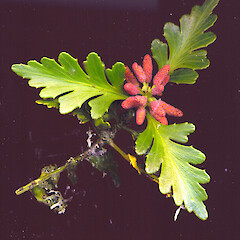Phyllocladus trichomanoides
Common name
tānekaha, celery pine
Synonyms
Phyllocladus trichomanoides D.Don var. trichomanoides, Phyllocladus rhomboidalis A.Rich.
Family
Phyllocladaceae
Flora category
Vascular – Native
Endemic taxon
Yes
Endemic genus
No
Endemic family
No
Structural class
Trees & Shrubs - Gymnosperms
NVS code
The National Vegetation Survey (NVS) Databank is a physical archive and electronic databank containing records of over 94,000 vegetation survey plots - including data from over 19,000 permanent plots. NVS maintains a standard set of species code abbreviations that correspond to standard scientific plant names from the Ngä Tipu o Aotearoa - New Zealand Plants database.
PHYTRI
Chromosome number
2n = 18
Current conservation status
The conservation status of all known New Zealand vascular plant taxa at the rank of species and below were reassessed in 2017 using the New Zealand Threat Classification System (NZTCS) – more information about this can be found on the NZTCS website. This report includes a statistical summary and brief notes on changes since 2012 and replaces all previous NZTCS lists for vascular plants.
Please note, threat classifications are often suggested by authors when publications fall between NZTCS assessment periods – an interim threat classification status has not been assessed by the NZTCS panel.
- Conservation status of New Zealand indigenous vascular plants, 2017 . 2018. Peter J. de Lange, Jeremy R. Rolfe, John W. Barkla, Shannel P. Courtney, Paul D. Champion, Leon R. Perrie, Sarah M. Beadel, Kerry A. Ford, Ilse Breitwieser, Ines Schönberger, Rowan Hindmarsh-Walls, Peter B. Heenan and Kate Ladley. Department of Conservation. Source: NZTCS and licensed by DOC for reuse under the Creative Commons Attribution 4.0 International licence.
2017 | Not Threatened
Previous conservation statuses
2012 | Not Threatened
2009 | Not Threatened
2004 | Not Threatened
Distribution
Endemic. New Zealand: North Island (widespread from Te Paki to about the northern Manawatū, after which it is scarce) and South Island (confined to the Marlborough Sounds, northern Richmond Range and North-west Nelson from Puponga south to about Kahurangi Light and across to Abel Tasman National Park.
Habitat
Found from sea level to c.1000 m a.s.l. tānekaha is a common tree in northern New Zealand where it is often found growing in association with kauri (Agathis australis) on ridge lines. Tānekaha is also common in secondary regrowth forest overlying poorly draining and/or infertile soils. It can be very common in reverting fire-induced gumland scrub. In the central North Island tānekaha-dominated forest is locally common overlying ignimbrite rock and this forest type is very much a feature of the northern Taupo - King Country - Atiamuri area where extensive tānekaha-dominated forests are present overlying such high aspect ratio ignimbrites as the Whakamaru Ignimbrite. Further south tānekaha is rarely such a major component of the forest canopy.
Wetland plant indicator status rating
Information derived from the revised national wetland plant list prepared to assist councils in delineating and monitoring wetlands (Clarkson et al., 2021 Manaaki Whenua – Landcare Research Contract Report LC3975 for Hawke’s Bay Regional Council). The national plant list categorises plants by the extent to which they are found in wetlands and not ‘drylands’. The indicator status ratings are OBL (obligate wetland), FACW (facultative wetland), FAC (facultative), FACU (facultative upland), and UPL (obligate upland). If you have suggestions for the Wetland Indicator Status Rating, please contact: [Enable JavaScript to view protected content]
FACU: Facultative Upland
Occasionally is a hydrophyte but usually occurs in uplands (non-wetlands).
Detailed description
Monoecious tree up to 25 m, trunk up to 1 m diameter; phylloclades alternate, pinnately arranged on whorled rhachides up to 300 mm long. Leaves of juveniles up to 20 mm long, narrow-linear, deciduous; of adults much smaller. Phylloclades 10–15 per rhachis, irregularly and broadly rhomboid, flabellately lobed, cuneate at base; lobes obtuse to truncate, margins minutely crenulate; leaf-denticles small, subulate, 1.5–3.0 mm long, up to 1.5 mm wide. Male strobili terminal in clusters of 5–10, pedicels 3–10 mm long; staminal portion c. 10 mm long, apiculus small, triquetrous; carpidia rather thick, marginal on reduced final phylloclades up to 30 mm long, in clusters of 6–8; seeds nutlike, exserted beyond white, fleshy, irregularly crenulate cupule, c. 3 mm long.
Similar taxa
Tānekaha is distinguished from mountain toatoa (Phyllocladus alpinus) by the phylloclades which are pinnately arranged on rhachis and from toatoa (P. toatoa) by the seeds which arranged singly on the margins of phylloclades.
Flowering
September–December
Flower colours
No flowers
Fruiting
January–April
Propagation technique
Easily grown from fresh seed. Seedlings transplant well and this species is sometimes common in cultivation. It is often grown as a specimen tree in parks and does well in urban areas on street side verges. Once established tānekaha is able to tolerate full light and considerable drought but young plants do better planted in a less exposed site or at least provided with plenty of water during their early stages of establishment.
Etymology
phyllocladus: Leaf branch, referring to the leaf-like stems
trichomanoides: Fern-like
Taxonomic Notes
A distinct as yet undescribed species allied to Phyllocladus trichomanoides is known from the 120-ha exsposure of ultramafic rock at North Cape, Te Paki. This unnamed species differs from P. trichomanoides by its shorter stature and spreading growth habit, longer phyllodes, larger fruits and longer fruiting season. It still awaits formal description. In the past this form had been referred to the hybrid P. toatoa × P. trichomanoides. However Phyllocladus toatoa is not known from Te Paki and the North Cape tree comes true from seed.
Attribution
Fact sheet prepared for NZPCN by P.J. de Lange 1 August 2004. Description adapted from Allan (1961).
References and further reading
Allan HH. 1961. Flora of New Zealand, Volume I. Indigenous Tracheophyta: Psilopsida, Lycopsida, Filicopsida, Gymnospermae, Dicotyledones. Government Printer, Wellington, NZ. 1085 p.
NZPCN Fact Sheet citation
Please cite as: de Lange, P.J. (Year at time of access): Phyllocladus trichomanoides Fact Sheet (content continuously updated). New Zealand Plant Conservation Network. https://www.nzpcn.org.nz/flora/species/phyllocladus-trichomanoides/ (Date website was queried)











